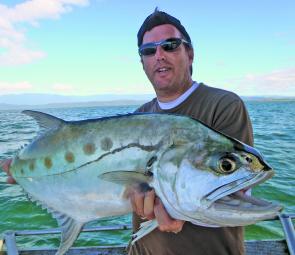The turn into the dry season has seen conditions in the tropics take on a new face. There are more days where we see high pressure systems from further down south pushing the trade mark southeasterly winds right up along the east coast.
The days are a mild comfortable temperature with little precipitation but the winds can make getting offshore a challenge at times. It is a matter of waiting for that window of opportunity when the seas calm out, and heading out to the reef is a must do fishing experience in the cooler months.
Already we’ve seen in a shift in momentum from most of our most prized species and the next few months is when they tend to hit their peak.
Albeit a slow start this year, the large-mouth nannygai are beginning to feed more consistently during the daylight hours and are backed up with some excellent action on the coral trout. The large-mouth can be found in the 30-50m range across the rubbly ground and also hovering around the extra deep pinnacles that shoot upwards from the ocean floor. The trout have also been found in a variety of depths from 40m and now right up into the shallows 15-20m deep.
Some days are better than others with the best results leading into the full and new moon phases. In saying that, the neap tides with less run have also been favourable for targeting the nannygai allowing skippers and boat drivers to successfully anchor up in the deepest of open waters where they are often found in huge schools.
Besides these two species, red emperor are popping up with more regularity. Their 55cm minimum size limit means you are tangling with decent fish if you land a legal one.
Reef mangrove jack have also shown a marked improvement and often they will fall foul to a floating dead or live bait suspended half way in the water column. Their characteristic explosive vertical surge back down to the depths is legendary and will test both angler and gear to the limit.
The Spanish mackerel are a lot more consistent nowadays hitting floating rigs, and June is the traditional start to the mackerel run in our part of the tropics. There are a host of other great species turning up in numbers at times including gold spot trevally, various cod species, black kingfish and heaps of the top notch smaller brigade such as sweetlip, Moses perch and stripeys.
The light tackle scene has also seen its fair share of action in recent times with long tail tuna, mac tuna and yellowfin tuna showing up within the outer reef systems, particularly in the waters receiving fresh currents direct from the Continental Shelf. The Spanish mackerel as already mentioned, are becoming more regular and once a strike zone has been established you should be able to prize out a few nice specimens in short time.
A lot of the more experienced skippers like to run a shallow and deep styled lure on the short lines, and on the outriggers they definitely run a couple of rigged garfish. The garfish more often than not will account for your bigger mackerel species. Interestingly, on many occasions a fish will hook up to one of the garfish and when the boat is pulled into neutral the other garfish will sink down through the water column and get nailed by another member of the school. A lot of double headers are achieved in this fashion.
For those with the stamina and commitment to target big GT, have also enjoyed reasonable success lately tangling with freight train models up to 25kg. This is a very specialised sport and there’s only couple of skippers in the region with the required knowledge to be consistently successful at this application. There are only certain tides and conditions which will put the advantage in your favour.
Inshore fishing has seen some interesting patches occur. The spectacular metre-sized queenfish have been making their annual appearance around our headlands, taking advantage of the bait supplies produced from after the wet season. Longtail tuna have also been in the same waters cashing in on the food supply and both these species can be enticed by blooping poppers across the surface.
Boils and swirls on the surface indicate where the fish are concentrating and often there will be a fluttering of sea birds hovering above.
In the rivers and creeks, jacks and barra have tailed off with the onset of cooler weather yet there is some good value across the flats targeting golden trevally and grunter. Fresh dead baits have been successful, particularly if the water is discoloured from the choppy incoming tides. The old dead bait certainly has its place in the tropics and can be successfully deployed in the cooler months across the shallower waters.
Fingermark have become a bit more active and you can usually entice one or two of these using a live sardine dropped down into the deeper sections of the system holding some structure.
Live prawns under a float are your best bet to coax a barra into action at the moment and sourcing big submerged logs or fallen trees are prime spots to test.
In a nutshell the offshore reef fishing kicks into overdrive from this point on and the rivers become a bit more challenging but still offer genuine value.
Reads: 1338
Jamie Beitzel on the Daintree Charters tapping into spectacular big queenfish action.




